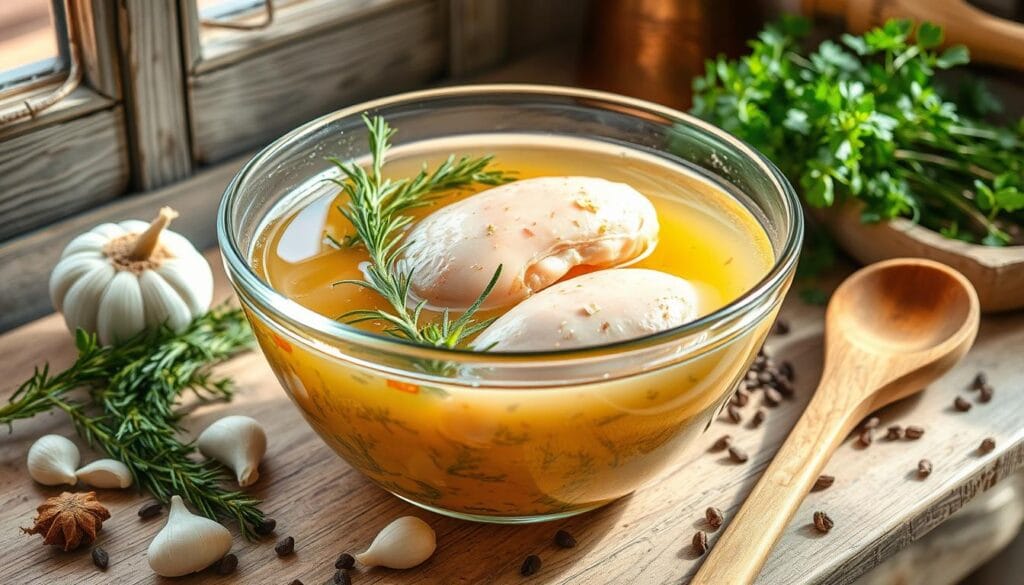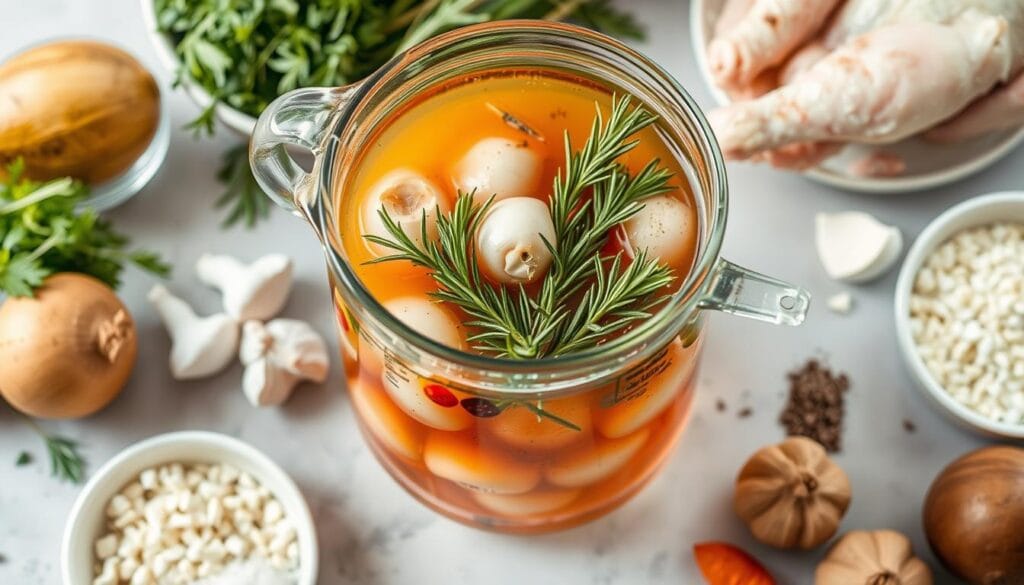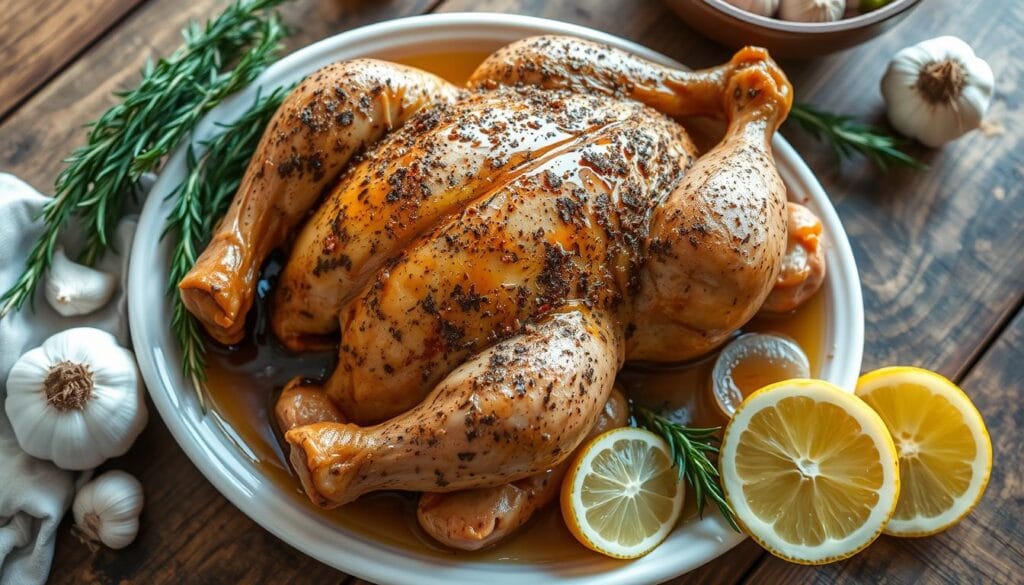Step-by-Step Chicken Brine Recipe for Beginners
As a seasoned home cook, I’ve always been fascinated by the transformative power of a good brine. Brining chicken can unlock a whole new world of flavor and texture. It makes even the most basic bird juicy and perfect.
If you’ve never tried brining before, this guide is for you. Say goodbye to dry, bland chicken. Hello to the most succulent, flavor-infused poultry you’ve ever tasted.
Brining your chicken may seem complex, but it’s surprisingly easy. With just a few simple ingredients and some time, you can make ordinary chicken into an extraordinary meal. This recipe works for whole birds, bone-in pieces, or boneless breasts. It ensures you get the perfect balance of seasoning and moisture every time.

So, let’s dive in and unlock the secrets of the ultimate chicken brine. Get ready to impress your friends and family with your newfound brining prowess!
Table of Contents
Uncovering the Magic: The Ultimate Guide to a Perfect Chicken Brine Recipe
Brining is a technique that enhances the flavor and tenderness of chicken. It uses a salt solution to break down the meat’s proteins. This process allows the chicken to absorb extra moisture and flavors, making it juicier and more flavorful.
The result is chicken that’s juicy, tender, and full of flavor.
How Brining Works
Brining works through osmosis. When chicken is soaked in saltwater, the salt and water molecules get into the meat. This makes the protein strands relax and the muscle fibers open up.
This makes the chicken better at holding onto moisture and flavors during cooking.
Benefits of Brining Your Chicken
- Improved moisture retention: Brined chicken stays juicy and flavorful, even when cooked.
- Enhanced tenderness: The salt in the brine softens the meat, making it more tender.
- Deeper flavor: The brine can add a variety of tastes, from herbs and spices to citrus and garlic.
Science Behind the Perfect Brine
The science of brining involves osmosis and protein denaturation. When chicken is in a brine, the salt concentration outside is higher than inside. This draws water into the chicken, making it tender and juicy.
The salt also changes the meat’s proteins, making it even more tender and moist during cooking.
“Brining is a game-changer, ensuring consistently juicy and flavorful chicken every time. It’s a simple technique that can transform even the most basic poultry dish into a culinary masterpiece.”
Essential Ingredients for Chicken Brine Recipe
Making the perfect chicken brine begins with knowing the key ingredients. At its core, the brine includes water and salt. But, it’s the optional aromatics and seasonings that really boost the flavor of your roasted chicken.
Basic Brine Components
The base of any chicken brine is water and salt. The usual mix is 2 tablespoons (30 grams) of salt per liter of water. This makes a 3% salt solution. It ensures your chicken is well-seasoned and full of flavor.
Optional Aromatics and Seasonings
- Garlic: Minced or crushed garlic adds depth and complexity to the brine.
- Peppercorns: Whole black peppercorns or a blend of peppercorns can provide a subtle heat and aroma.
- Herbs: Fresh or dried herbs like rosemary, thyme, and sage lend their distinct flavors.
- Citrus: Sliced lemon, lime, or orange peel can introduce a bright, tangy note.
- Soy sauce: A splash of soy sauce can enhance the umami character of the brine.
- Sugar: A touch of honey, brown sugar, or maple syrup can balance the saltiness.
- Olive oil: A small amount of olive oil can help to tenderize the chicken and add richness.
Recommended Salt Types and Ratios
For brining, kosher salt is the best choice. Its larger crystals help distribute evenly into the meat. The standard ratio is 2 tablespoons (30 grams) of kosher salt per liter of water. This makes a 3% salt solution. You can easily adjust the brining ratio to suit your taste.
Equipment and Tools Needed for Brining
To make perfect chicken brine, you need some key tools. The right setup helps your chicken soak up the brine evenly. This results in chicken that’s irresistibly juicy and packed with flavor.
You’ll need a big, safe container for brining. This can be a stainless steel or enameled pot, a brining bag, or a food-grade bucket. It should fit your chicken and the brine solution.
You also need a medium saucepan with a lid to mix the brine. A large bowl is good for mixing the brine before putting it in the container. And, a wooden spoon is essential for stirring the brine.
Lastly, have reliable measuring cups and spoons ready. Accurate measurements are key for the right brine flavor and texture.
With these tools, you’re ready to brine like a pro. Enjoy your juicy, flavorful chicken every time.
| Equipment/Tool | Purpose |
|---|---|
| Large food-safe container (stockpot, brining bag, or plastic bucket) | Holds the chicken and brine solution |
| Medium saucepan with lid | Heats and dissolves brine ingredients |
| Large mixing bowl | Prepares the brine solution |
| Large wooden spoon | Stirs and incorporates brine ingredients |
| Measuring cups and spoons | Ensures precise brine measurements |
With these tools, you’re ready to brine like a pro. Enjoy your juicy, flavorful chicken brine method every time.
Perfect Brine Solution Ratios
To make the perfect chicken brine, you need to know the right salt-to-water ratio. You also need to balance the flavors with aromatic ingredients. By following these simple steps, you can make a brine that turns your chicken into a juicy, tender dish.
Salt-to-Water Measurements
The basic chicken brine ratio is 2 tablespoons of salt per liter of water. This mix is perfect for adding moisture and flavor to your chicken. For the best results, use kosher or sea salt in your brine.
Aromatics Proportions
To enhance your brine, add aromatic ingredients. Use 3-6 sprigs of fresh herbs and 4 large cloves of garlic. You can also add 1 sliced white onion, 1-2 sliced lemons, bay leaves, and cracked peppercorns. Adjust the amounts based on your taste and the brine’s size.
Remember, the chicken brine ratios are key to a great dish. By following these tips, you’ll make a perfectly seasoned and juicy chicken every time.

Step-by-Step Preparation Method
Making the perfect chicken brine recipe is easy and makes your chicken juicy and flavorful. Here’s how to make your own brine for grilled chicken or other cooking methods:
- In a saucepan, mix the key brine ingredients: 4 1/2 tablespoons of Morton’s kosher salt, 1/2 cup granulated sugar, and cold tap water.
- Heat the mix until it boils, stirring constantly until the salt and sugar dissolve.
- Take the pan off the heat and let it sit, covered, for 10 minutes to soak up flavors.
- Cool the brine down by pouring it over ice. This step is key for food safety.
- Put your chicken pieces or whole bird in a big container. Pour the cooled brine over it, making sure the meat is covered.
- Put the brined chicken in the fridge for the right time: 30 minutes to 1 hour for breasts, or up to 8 hours for whole birds or big cuts.
- When it’s time to cook, take the chicken out of the brine. Pat it dry with paper towels. Then, cook it your favorite way. Don’t rinse the chicken or add extra salt, as the brine has already seasoned it well.
To add more flavor, you can add things like garlic, onion, herbs, or spices to your brine. Adding a tablespoon of garlic granules can give your chicken brine recipe a tasty garlic flavor.
The secret to success is to brine for the right amount of time, based on the chicken cut. Brining too long can make the chicken too salty and soggy. So, always follow the recommended brining time for the best taste.
Optimal Brining Times for Different Cuts
Brining chicken can make it taste better and stay juicier. But, how long you brine it matters a lot. The right brining time depends on the chicken cut. Let’s look at the best brining times for different chicken pieces.
Whole Chicken Timing
For a whole chicken, brine it for at least 4 hours or even overnight. This long brining time lets the brine soak into the whole bird. It makes sure the flavor and moisture are evenly spread.
Chicken Parts Guidelines
- Bone-in chicken parts, like thighs and drumsticks, need about 4 hours of brining.
- Skinless chicken breasts, being softer, only need 2 hours of brining.
Maximum Brining Duration
It’s tempting to brine chicken for longer, but there’s a limit. Brining for more than 4-6 hours in the fridge (or 2-3 hours at room temperature) can make it too salty. The goal is to find the right balance of flavor and tenderness.
| Chicken Cut | Recommended Brining Time |
|---|---|
| Whole Chicken | 4 hours to overnight |
| Bone-in Chicken Parts | 4 hours |
| Skinless Chicken Breasts | 2 hours |
| Maximum Brining Duration | 4-6 hours in the refrigerator or 2-3 hours at room temperature |
Remember, the chicken brine time is key to perfect seasoning and juiciness. By following these tips, you’ll get great-tasting chicken at home, just like in a restaurant.
Common Brining Mistakes to Avoid
Brining chicken can significantly enhance its taste and texture. However, there are some common mistakes to avoid. Knowing these can help you make your chicken brine method a success every time.
One big mistake is over-brining. If you leave your chicken in the brine too long, it can become too salty. The right brining time depends on the meat, from 1-2 hours for chicken breasts to 12-24 hours for a whole turkey.
- Whole chicken or turkey breast: 4-6 hours
- Pork loin: 6-8 hours
- Chicken breasts, 1-inch thick pork chops, and pork tenderloins: 1-2 hours
Choosing the wrong container for the brine is another mistake. Stay away from aluminum or copper as they can give your meat bad flavors. Use non-reactive materials like plastic, glass, or stainless steel instead.
Be sure the brine is fully cooled before adding the chicken. If it’s warm, it can start cooking the meat unevenly. This can mess up the texture and taste.
Lastly, always keep the chicken refrigerated while it’s brining. Not doing so can be unsafe and lead to bacterial growth.
By avoiding these common chicken brine method mistakes, you’ll get perfectly brined poultry every time.
| Brining Mistake | Consequence | How to Avoid |
|---|---|---|
| Over-brining | Overly salty meat | Follow recommended brining times based on cut |
| Using reactive containers | Off-flavors in the meat | Use non-reactive vessels like plastic, glass, or stainless steel |
| Adding chicken to warm brine | Partial cooking, uneven texture and flavor | Ensure the brine is fully cooled before adding the chicken |
| Leaving chicken at room temperature while brining | Bacterial growth, food safety risk | Always refrigerate the chicken during the brining process |
By avoiding these common chicken brine method mistakes, you’ll be well on your way to achieving perfectly brined poultry every time.
Cooking Your Brined Chicken
After taking your chicken out of the brine and drying it well, it’s time to cook. Brined chicken cooks faster, so adjust your cooking times. Use a thermometer to check the meat’s temperature reaches 165°F (74°C).
Temperature Guidelines
Brined chicken needs different cooking temperatures and times. Here’s how to cook it right:
- Brined chicken breasts: Cook to an internal temperature of 160°F (71°C).
- Brined chicken thighs: Cook to an internal temperature of 175°F (79°C).
- Whole brined chicken: Cook to an internal temperature of 165°F (74°C) in the thickest part of the breast and 175°F (79°C) in the thigh.
Cooking Time Adjustments
When cooking brine recipe for roasted chicken or brine recipe for grilled chicken, adjust the time. Cut the cooking time by 20% to avoid drying out the meat.
For example, grill a whole chicken for 48 minutes instead of 60. Roast chicken breasts for about 24 minutes instead of 30.
To get crispy skin, let the chicken dry in the fridge for an hour before cooking. This helps the skin get golden brown.

Conclusion
Brining is a simple yet powerful technique that makes chicken dishes juicier and more flavorful. By following this guide, you now know how to make the perfect chicken brine recipe. This simple step can help you achieve restaurant-quality results right in your own kitchen.
Try different aromatic ingredients and seasonings to make your chicken brine recipe your own. Whether you’re new to cooking or have lots of experience, brining will keep your chicken moist and full of flavor. It’s a skill that makes every dish delicious.
Start using brining to make your juicy chicken dishes even better. With this guide, you’re on your way to becoming a brining expert. You’ll impress everyone with your tasty, restaurant-quality meals.
FAQ
What is the basic salt-to-water ratio for a chicken brine?
For a chicken brine, use 2 tablespoons (30 grams) of salt per liter of water. This makes a 3% salt solution.
What are some optional aromatics and seasonings that can be added to a chicken brine?
You can add garlic, peppercorns, herbs, citrus, soy sauce, sugar, and olive oil to a chicken brine.
How long should I brine a whole chicken, bone-in pieces, and skinless breasts?
Brine times are: whole chickens – at least 4 hours or up to overnight, bone-in pieces – 4 hours, and skinless breasts – 2 hours.
What is the maximum brining duration I should avoid?
Avoid over-brining to prevent overly salty meat. Don’t go beyond the recommended brining times for each chicken cut.
What type of container should I use for brining?
Choose a large, food-safe container like a stainless steel or enameled stockpot, brining bag, or food-grade plastic bucket. Stay away from aluminum or copper.
How should I prepare the chicken after brining?
After brining, remove the chicken and pat it dry about an hour before cooking. Brined chicken cooks 20% faster, so adjust cooking times.








One Comment
Comments are closed.